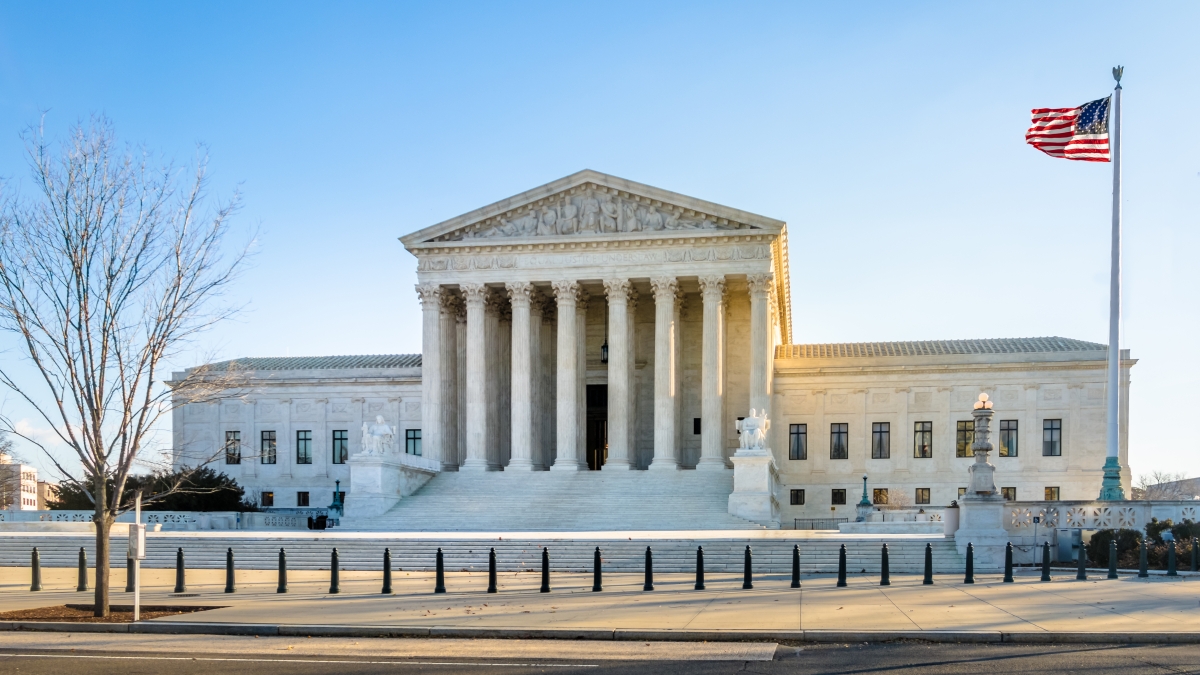ASU Law Supreme Court experts analyze court's new ethics code

The U.S. Supreme Court has adopted an ethics code for the first time in its long history. Experts from the Sandra Day O'Connor College of Law at ASU examine what that means for the nation's highest court moving forward. Stock photo
Since it began presiding over the country’s legal system at its inaugural session in 1790, the U.S. Supreme Court has never had to abide by an official ethics code.
While judges in other court systems had to adhere to specific ethical rules, justices with lifetime appointments on the Supreme Court have not. Elected officials, members of the public and more have been asking for change in recent months. An official ethics code was launched in November 2023.
ASU News spoke with two experts at the Sandra Day O’Connor College of Law at Arizona State University — Justin Weinstein-Tull, associate professor of law, and Stefanie Lindquist, Foundation Professor of law and political science who also serves as the executive director of the Center for Constitutional Design — on the subject to find out what it means and how it might be enforced.
Question: Why was there such a demand for the Supreme Court to adopt an ethics code?
Weinstein-Tull: In the months leading up to the Supreme Court’s announcement of a code of conduct, journalists ... had made connections between justices of the Supreme Court — and especially Justice Clarence Thomas — and various billionaires, including Harlan Crow. The reporting alleged that Justice Thomas had received gifts from Crow over the years — things like trips on a private jet and free vacations — that he may have failed to disclose on his financial disclosure forms.
These gifts, especially considering that they were not publicly disclosed, raised ethics concerns. As a Supreme Court justice, Thomas regularly hears cases that could have financial implications for Crow. This was doubly concerning: not only was it impossible to know whether these gifts affected Thomas’s jurisprudence, but there was no ethics framework applicable to the Supreme Court to guide our thinking on what was and what wasn’t appropriate actions for Thomas to take.
Lindquist: The news outlet Politico conducted a thorough analysis of certain financial disclosures by the Supreme Court justices. Those disclosures are required by law under the Ethics in Government Act. Several issues arose in that review, including a failure of a few justices to report large gifts of travel and accommodations that involve substantial amounts of money. Thereafter, several senators, including Dick Durbin and Elizabeth Warren, proposed bills to require that Supreme Court justices comply with the ethical rules that bind other federal judges. Although those bills were not adopted into law, they nevertheless may have placed the court under some pressure to adopt a code and thus conform their actions to ethical standards similar to those applicable to other federal judges.
Q: Do other courts or similar organizations have ethics codes? How does this one compare?
Lindquist: Yes, all other federal judges are governed by codes of ethics and other federal statutes establishing guidelines for recusal or even removal. The Supreme Court’s code mirrors many of those existing guidelines, but — unlike guidelines for lower courts — it places a finger on the scale against recusal because of the court’s unique structure and composition.
Q: What are your thoughts on the code that was introduced? What’s missing from it, if anything, that should be included?
Lindquist: The Supreme Court is unique in the federal judiciary for several reasons. It is the only court specifically mentioned in the U.S. Constitution. It is limited in size such that recusal carries significant consequences for the court’s decision-making; when only eight justices hear a case, a split four-to-four (vote) means an automatic affirmance of the court below. For that reason, the court adopted a “duty to sit” that shifts the justices’ recusal obligations in favor of sitting on the court unless the reasons for disqualification are extremely clear. What’s missing is any public database that records the court’s evaluation of potential conflicts.
Chief Justice Roberts remarked in the notes accompanying the code that the court was considering an automated process to ferret out any potential financial or other personal conflicts that might lead the public to question the justices’ impartiality or require recusal. Of course, the elephant in the room is the absence of any enforcement mechanism. In that sense, the code reflects a commitment to certain ethical rules but still leaves the court as a wholly self-governing and self-monitoring body.
Q: How will it be enforced? Who is the regulatory body behind the Supreme Court?
Weinstein-Tull: The code of conduct has no legal enforcement mechanism. However, there are two forms of non-legal enforcement that may still exist. The first is self-enforcement. The Supreme Court, like every institution, is governed by norms that — while nonlegal in nature — can exert real pressure on individual members to act in certain ways. If this code of conduct is embraced by the individual justices — and in theory, they have all agreed to it — that social pressure may be an effective mechanism for compliance.
The second nonlegal enforcement mechanism is the same one that has always existed: the political remedy of impeachment. Supreme Court justices are rarely impeached — the last impeachment was in 1805 — but it is certainly possible that this code could give the political branches material to initiate an impeachment investigation. In other words, flagrant violations of this code by a Supreme Court justice might, in some circumstances, provide political motivation for Congress to consider impeachment.
Q: What does this mean for the history of the Supreme Court?
Weinstein-Tull: The court is always juggling many balls at once: which cases to take, how to resolve them and how to maintain legitimacy in the eyes of the people, among others. As Alexander Hamilton noted, the judiciary “has no influence over either the sword or the purse.” Its sole power is that of “judgment,” and it relies on its own institutional legitimacy to ensure that government actors and private citizens respect its judgments. That legitimacy derives in part from the people’s confidence that the court is operating in good faith, and not corruptly, or for the enrichment of its individual members. The court wants to maintain its legitimacy, which is why, I think, it moved so quickly to institute this code of conduct after the ProPublica reporting came out. I’m not sure what this means for the history of the court, but I think it tells us that the court is closely attuned to political pressures and that it sees the continuing ethical behavior of its members as important to maintaining the people’s trust.
Lindquist: The rule of law only operates effectively where the court system is viewed by the public as legitimate and impartial. In recent years, the Supreme Court’s public approval ratings have plummeted, often for reasons relating to divisive issues such as abortion or guns. The public has come, in many respects, to view the court as a partisan operation. News stories about potential conflicts of interest only exacerbate this trend. Whether or not the code is enforceable, its main impact may be symbolic. But symbols are important, and the code presents a significant statement of the court’s collective endorsement of ethical standards. In that respect, it may serve to counter the negative press the justices have received of late.
More Law, journalism and politics

Cronkite School launches Women Leaders in Sports Media live-learn program
Women in a new sports media program at Arizona State University got a solid game plan from a sports veteran at an Aug. 20 welcome event.“Be humble, be consistent and be a solver,” Charli Turner…

ASU center to host the Pursuits of Education and Excellence Symposium
The Center for the Study of Race and Democracy (CSRD) at Arizona State University is introducing the Pursuits of Education and Excellence Symposium as part of an ongoing initiative to commemorate the…
ASU journalism students dominate NATAS Student Production Award nominations
Students at Arizona State University’s Walter Cronkite School of Journalism and Mass Communication dominated the nominations field of the prestigious Rocky Mountain Southwest Chapter of the National…

